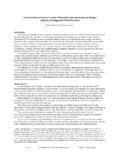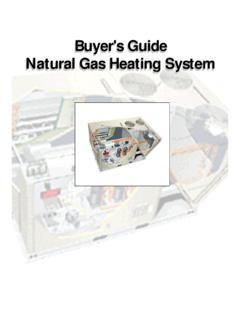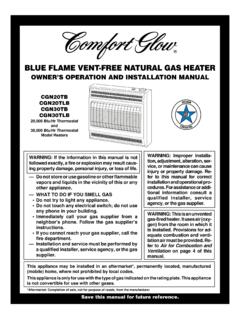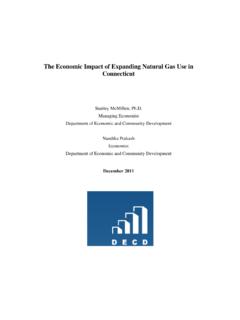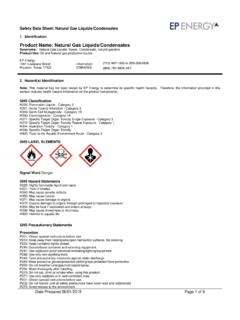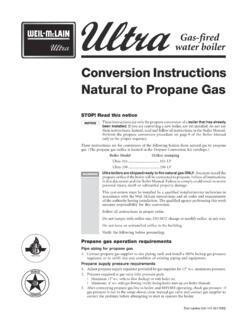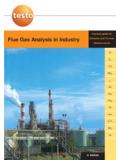Transcription of Standardized Terminology for Combustion …
1 Standardized Terminology for Combustion appliances and Combustion Safety Testing Page 1 Standardized Terminology for Combustion appliances and Combustion Safety Testing Air-Free Carbon Monoxide A measurement of CO in an air sample or flue gas that takes into account the amount of excess air (oxygen, O2) in the sample, incorporating an adjustment to the as-measured CO ppm value, thus simulating air-free (oxygen-free) conditions in the sample. Usually measured in units of parts per million (ppm). See As-Measured Carbon Monoxide. Ambient Surrounding conditions. Usually refers to the air around a Combustion appliance. ANSI American National Standards Institute. ASHRAE American Society of Heating, Refrigerating, and Air-Conditioning Engineers, Inc. As-Measured Carbon Monoxide A measurement of CO in a sample of air or flue gas that does not take account of the amount of excess air (oxygen, O2) diluting the CO concentration.
2 Usually measured in units of parts per million (ppm). See Air-Free Carbon Monoxide. Appliance Depressurization Limits The ambient depressurization at which the venting of a Combustion appliance is likely to become hazardous for those testing the appliance or for the usual occupants of the building. Refer to Table 1 for depressurization limits for most vented Combustion appliances . Atmospheric Burner A burner utilizing atmospheric Combustion . (Based on NFPA 54) Atmospheric Combustion Combustion which takes place under atmospheric pressure at a given altitude. (Based on NFPA 54) Atmospheric Pressure The weight of air and its contained water vapor on the surface of the earth. At sea level this pressure is pounds per square inch. (Based on NFPA 54) Balanced Flue Vent System Term used for oil-fired systems to indicate a direct-vent appliance with positive pressure in the vent connector through which the gases of Combustion pass.
3 Barometric Damper See Draft Regulator. Barometric Draft Regulator - See Draft Regulator. Boiler A space heating appliance that heats water with hot Combustion gases. Breeching or Breech See Vent Connector. Carbon Monoxide Emissions Carbon monoxide (CO) is an odorless and colorless gas that can cause sickness and death. To measure the CO emissions in flue gas, the CO sample must be taken before Standardized Terminology for Combustion appliances and Combustion Safety Testing Page 2 dilution air enters the vent system. CO emissions are measured in parts per million (ppm). See Air-Free Carbon Monoxide and As-Measured Carbon Monoxide. Category I Gas Appliance An appliance that operates with negative static pressure in the vent and a temperature that is high enough to avoid condensation in vent. Comment: May be atmospheric or fan-assisted Combustion ; airtight vent connector is not required.
4 See Figure 1. (Based on NFPA 54) Category I Fan-Assisted Gas Appliance An appliance that operates with negative static pressure in the vent, a temperature that is high enough to avoid condensation in vent, and an integral fan to draw a controlled amount of Combustion supply air through the Combustion chamber. Comment: Airtight vent connector is not required; induced Combustion fan installed by manufacturer. See Figure 2 (Based on NFPA 54) Category II Gas Appliance An appliance that operates with negative static pressure in the vent and a temperature that is low enough to cause excessive condensation in the vent. Comment: No or very little equipment in this category. (Based on NFPA 54) Category III Gas Appliance An appliance that operates with positive static pressure in the vent and a temperature that is high enough to avoid condensation in vent.
5 Comment: Airtight vent connector; vented through the wall; forced draft. (Based on NFPA 54) Category IV Gas Appliance - An appliance that operates with positive static pressure in the vent and a temperature that is low enough to cause excessive condensation in the vent. Comment: Airtight vent connector; vented through the wall; forced draft; often referred to as a 90-plus or condensing unit. See Figure 3. (Based on NFPA 54) CAZ See Combustion Appliance Zone. Central Return System of ducts or passages for distribution return air, which connect different areas of the house to a central location at the forced air furnace. Chimney Flue A passageway in a chimney for exhausting Combustion gases to the outdoors. (Based on NFPA 54) Cleanout Opening An opening in a chimney (usually at its base) to allow inspection and the removal of ash or debris.
6 (Based on NFPA 211). Combustion Appliance Zone (CAZ) Room and enclosed air volume that contains a Combustion appliance. This may include, but is not limited to, a mechanical room, mechanical closet, or main body of the house. Common Vent The portion of the vent or chimney through which products of Combustion from more than one appliance pass. (Based on NFPA 54) Standardized Terminology for Combustion appliances and Combustion Safety Testing Page 3 Concentrically Constructed Direct-Vent A direct-vent appliance that has an exhaust-gas vent and a Combustion -supply air vent arranged in a concentric fashion, , one vent is inside the other with a space between the walls of each. Comment: Mobile home furnace vents are usually constructed this way; some Category I, direct-vent water heaters are constructed this way.
7 Dilution Air Air that enters a draft hood or draft regulator of a Category I, natural draft appliance from the room in which the appliance is located. (Based on NFPA 54) Direct-Vent Appliance A Combustion appliance for which all Combustion gases are vented to the outdoors through an exhaust vent pipe and all Combustion supply air is vented to the Combustion chamber from the outdoors through a separate, dedicated supply-air vent. Comment: Most direct-vent gas appliances are Categories III and IV, but some are Category I; some direct-vent appliances utilize Concentrically Constructed Direct-Vent . (Based on NFPA 54) Downdraft Air flowing down a chimney or vent during the appliance off-cycle. Draft A pressure difference that causes Combustion gases or air to move through a vent connector, flue, chimney, or Combustion chamber.
8 May be natural draft, induced draft, or forced draft. Draft is often measured with a draft gauge (manometer or pressure gauge). (Based on NFPA 54) Draft Diverter See Draft Hood. Draft Fan A mechanical fan used in a venting system to augment the natural draft in gas- and oil-fired appliances . These electrically operated, paddle-fan devices are installed in vent connectors. (Based on NFPA 211) Draft Hood A nonadjustable device built into an appliance or a part of the vent connector that is intended to 1) provide for escape of flue gases if blockage or backdraft occurs, 2) prevent a downdraft of outdoor air from entering the appliance, 3) neutralize the effect of stack action of the chimney, and 4) lower the dew point temperature of the flue gas by the infusion of ambient room air. (Based on NFPA 54) Draft Regulator An adjustable and self-regulating damper attached to a chimney or vent connector for the purpose of controlling draft.
9 A draft regulator can reduce draft; it cannot increase draft. Fan-Assisted Combustion A Combustion appliance with an integral fan to draw Combustion supply air through the Combustion chamber. Comment: Category I fan-assisted gas furnaces utilize this method of Combustion air regulation. (Based on NFPA 54) Forced Draft A vent system for which a fan installed at the Combustion appliance moves Combustion gases to the outdoors with positive static pressure in the vent pipe. Because of this positive pressure, the vent connector must be air-tight. Comment: Normally Category III or IV appliances ; usually no draft diverter or barometric damper; fan for venting Combustion gases at or near appliance; usually vented through the wall; may be condensing. (Based on NFPA 54) Standardized Terminology for Combustion appliances and Combustion Safety Testing Page 4 Furnace A space heating appliance that heats air with hot Combustion gases.
10 Gas Oven Bake Burner Oven burner used for baking located just below the oven compartment floor. Gas Oven Broiler Burner Oven burner used for broiling located at the top of the oven compartment. Inches of Water Column (IWC) A non-metric unit of pressure difference. One IWC is equal to about 250 Pascals. Induced Combustion See Fan-Assisted Combustion . Induced Combustion Fan A mechanical device intended to pull a consistent volume of Combustion supply air through the Combustion area on a Category I, fan-assisted, gas-fired appliance. See Fan-Assisted Combustion . Induced Draft A vent system for which a fan installed at or very near the termination point of the vent pipe moves the Combustion gases to the outdoors with negative static pressure in the vent pipe. Comment: Normally Category I appliances ; fan for venting Combustion gases at point of exit to outdoors); vented through the wall.

